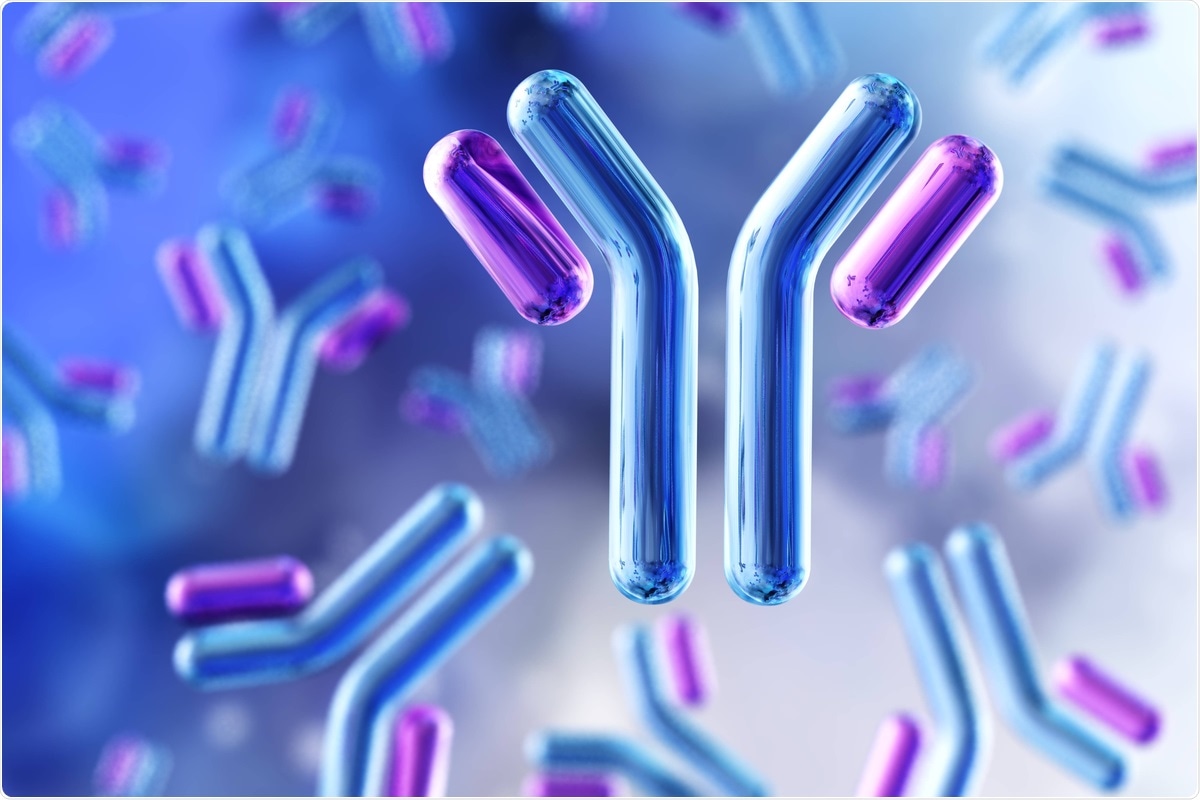Home » Health News »
8G3 broad-spectrum antibody effective against all SARS-CoV-2 variants, including Omicron
In a recent study posted to the bioRxiv* preprint server, researchers assessed the efficacy of 8G3, a B-cell neutralizing antibody, and several emergence use authorization (EUA) antibodies against severe acute respiratory syndrome coronavirus 2 (SARS-CoV-2) variants, including the most recent Omicron variant.
 Study: Efficient Neutralization of SARS-CoV-2 Omicron and Other VOCs by a Broad-Spectrum Antibody 8G3. Image Credit: ustas7777777 / Shutterstock.com
Study: Efficient Neutralization of SARS-CoV-2 Omicron and Other VOCs by a Broad-Spectrum Antibody 8G3. Image Credit: ustas7777777 / Shutterstock.com
The rampant spread of SARS-CoV-2 worldwide has led to the rapid development of several coronavirus disease 2019 (COVID-19) vaccines.
Although passive immunity has been conferred by the vaccines through the generation of antibodies against the original SARS-CoV-2 strain’s spike (S) protein, the neutralization potency of these antibodies is inadequate against novel variants. Previous studies have reported the efficacy of EUA antibodies against the pseudo-typed Omicron variant; however, data on their immunogenicity against the authentic viral strain is limited.
About the study
In the present study, researchers assess the neutralization potential of a B cell neutralizing antibody 8G3 repertoire designed from early COVID-19 convalescent patients. They also analyzed the concentration-based neutralization ability of several EUA antibodies that target different epitope groups against the SARS-CoV-2 Omicron and WA1/2020 strains. The structure of the Omicron S protein was also analyzed.
For the analysis, a pseudovirus was created with the three-plasmid transfection system. Moreover, 293T-angiotensin-converting enzyme 2 (ACE2) cells that demonstrated the top 1% fluorescent activity indicative of high ACE2 expression were used.
For testing viral neutralization activity, ten-fold serial dilutions of antibodies mixed with equal volumes of diluted pseudoviruses were used. The S1-mFc recombinant protein and fluorescein isothiocyanate (FITC)-labeled goat anti-mouse immunoglobulin G (IgG) antibody were used as the primary and secondary antibodies, respectively, which reacted with a substrate to emit fluorescence as a positive neutralization response. The half-maximal inhibitory concentration (IC50) values were also obtained.
Study findings
Antibodies 13A12, 8C12,3A4, 9A10, 11D, 32B8, 9B10, 9E12, and 9C4 decreased neutralization from 100% against the authentic WA1/2020 strain to about 20% against the novel Omicron variant at 1 μg/mL concentrations. Only 9D11, 7G10, and 8G4 antibodies retained 77%, 53%, and 63%, neutralization ability against Omicron at 1 μg/mL concentration, respectively. The neutralizing capacity of 9D11 and 8G4 was moderate, with the IC50 values of 0.6584 and 1.0670 μg/mL, respectively.
Although more than 50% of the antibodies effective against the original SARS-CoV-2 strain were ineffective against Omicron, 8G3 demonstrated equivalent potent activity against Omicron and WA1/2020 strains with effective IC50 concentrations of 0.137 μg/mL and 0.080 μg/mL, respectively.
The IC50 values of 8G3 were 0.0825, 0.0044, 0.0210, 0.0147, and, 0.0140 μg/mL against the Alpha, Gamma, Beta, Delta, Kappa, and WA1/2020 pseudo viral systems, respectively. This finding was indicative of the broad spectrum of action against 8G3 all SARS-CoV-2 variants of concern (VOCs).
Casirivimab, Etesevimab, Bamlanivimab, and Imdevimab neutralized the authentic SARS-CoV-2 strain with low IC50 values; however, these clinically used antibodies were completely ineffective against Omicron. Sotrovimab was the only antibody that retained partial Omicron neutralization activity with a demonstrated IC50 value of 6.409 μg/mL.
Comparatively, 8G3 was 47-fold more efficacious than Sotrovimab against the Omicron variant.
With greater than 30 mutational sites in the N-terminal domain (NTD) and the receptor-binding domain (RBD) region, the Omicron S disables antibodies and binds to the ACE2 receptor with ten times more affinity as compared to the wild-type SARS-CoV-2 strain. These mutations reshape the S confirmation and shift the spatial positions of atoms, thereby leading to changes in antibody binding and disabling of the host antibodies.
Numerous mutations in the Omicron variant lead to S protein reshaping and shifts in spatial positions of antibody binding, which makes the S protein antibody-evasive. Omicron mutations are majorly present in front of the ACE2 interaction interface, which may be due to the poor neutralization efficacy of the EUA antibodies.
Casirivimab, Bamlanivimab, and Etesevimab, with epitopes that overlap at the RBD-ACE2 region, were ineffective against Omicron. Comparatively, Sotrovimab, with no epitope overlapping with the RBD-ACE2 binding site, demonstrated partial neutralization action. However, Sotrovimab’s efficacy was reduced to half due to the presence of the N440K and G339D and mutations in the epitope.
Conclusions
The 8G3 broad-spectrum antibody demonstrated efficient neutralization capacity against the SARS-CoV-2 Omicron variant, as well as other strains of SARS-CoV-2. Although Omicron is highly transmissible and makes protection by EUA antibodies challenging, the infection can be controlled by broad-spectrum antibodies that target the RBD-ACE2 interface.
Given its non-regressed Omicron neutralization, the 8G3 antibody can be considered a preserved epitope that does not interact with Omicron S protein mutation sites.
*Important notice
bioRxiv publishes preliminary scientific reports that are not peer-reviewed and, therefore, should not be regarded as conclusive, guide clinical practice/health-related behavior, or treated as established information.
- Ma, H., Tseng, C. K., Zong, H., et al. (2022). Efficient Neutralization of SARS-CoV-2 Omicron and Other VOCs by a Broad-Spectrum Antibody 8G3. bioRxiv. doi:10.1101/2022.02.25.482049 https://www.biorxiv.org/content/10.1101/2022.02.25.482049v1
Posted in: Drug Discovery & Pharmaceuticals | Medical Science News | Medical Research News | Disease/Infection News
Tags: ACE2, Angiotensin, Angiotensin-Converting Enzyme 2, Antibodies, Antibody, B Cell, Cell, Coronavirus, Coronavirus Disease COVID-19, covid-19, Efficacy, Enzyme, Fluorescence, immunity, Immunoglobulin, Mutation, Omicron, Plasmid, Protein, Pseudovirus, Receptor, Respiratory, SARS, SARS-CoV-2, Severe Acute Respiratory, Severe Acute Respiratory Syndrome, Sotrovimab, Syndrome, Transfection

Written by
Pooja Toshniwal Paharia
Dr. based clinical-radiological diagnosis and management of oral lesions and conditions and associated maxillofacial disorders.
Source: Read Full Article



